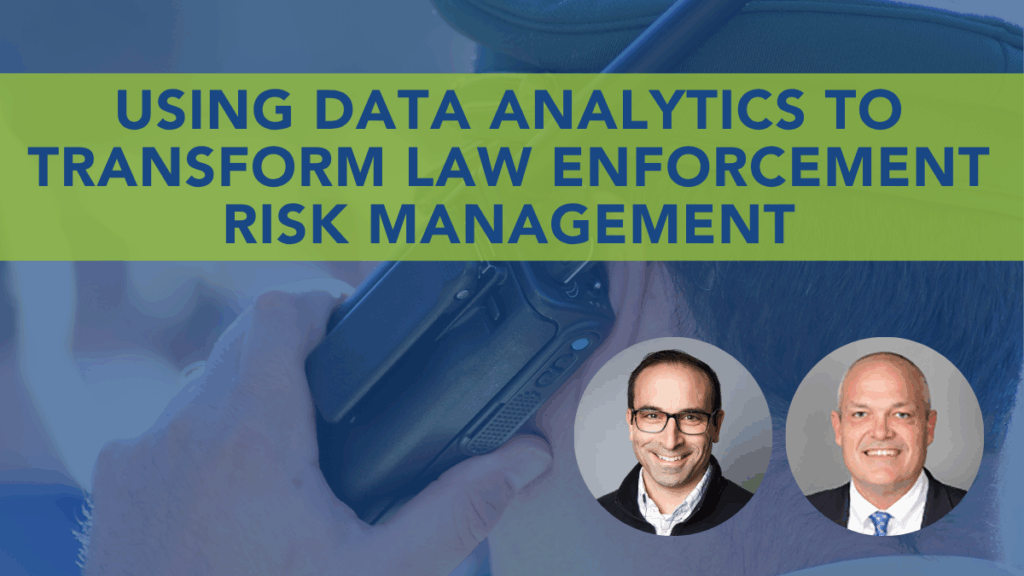Adopting an Early Intervention System: A Blueprint for Success
Posted
November 6, 2023
Share:

An Early Intervention System (EIS) can be a crucial asset for law enforcement agencies interested in managing their risk, in part by identifying officers who need assistance or support. The right system should monitor officer behavior and performance data to identify potential issues early, enabling focused interventions to minimize misconduct. However, the successful adoption of an EIS involves nuanced considerations in change management, data utilization, stakeholder engagement, implementation, and outcome measurement. This blueprint outlines essential factors in each area and serves as a roadmap for those agencies considering an EIS for optimizing officer performance.
Managing Change with Data
Introducing an EIS to an agency constitutes a significant cultural and technological shift that requires meticulous planning. According to an IACP policy document published in May 2020, agencies should consider several essential factors before moving forward with an EIS, such as:
- The time commitment to administer the program
- Deciding which agency-specific data points are critical for tracking and identifying performance trends
- Establishing how that data will be collected, tracked, and used
- Establishing policy for mapping potential actionable next steps once that data is extrapolated
- Having alignment on who will be managing the execution and oversight of those next steps
Change management within any organization is never a light undertaking; it requires a strong commitment to achieve the objective at hand. For law enforcement agencies adopting an EIS it can mean the difference between helping struggling officers get back on track to become more productive in a non-punitive way — versus missing the opportunity to give them the incremental attention they need.
Using Data Effectively
The effectiveness of an EIS hinges on the quality of its data. Best practices for data application are:
- Indicator selection: Prioritize in-depth data points that correlate closely with risk, such as arrest history, use of force incidents, internal affairs complaints, and missed court appearances. As stated in PERF’s 2015 article, Managing the Risks of Officer Misconduct and Failure through Early Intervention Systems: “Careful selection of data indicators based on those most predictive of risk is crucial for an EIS to flag situations accurately.”
- Context analysis: Understanding the situations surrounding data points is critical for distinguishing meaningful trends — driven by complex, nuanced factors, such as adverse incidents, sequence of events, patterns of behavior and peer comparisons.
- Ongoing indicator updates: Regular evaluations can guide adjustments for iterative learning, so that your EIS gets smarter and more efficient over time.
- Data system integration: an EIS should be built on a modern suite of software with structured and accessible data — so that it’s easily integrated with incident data-capture systems, including computer-aided dispatch (CAD) systems and record management systems (RMS) — as well as any existing personnel management systems in place, for a holistic ‘data in’ view that connects disparate information.
Measuring Outcomes
Quantifiable metrics are vital for realizing the impact of an EIS. Best-practice performance indicators include:
- A predictive model that identifies patterns of problematic behavior and patterns of exceptional conduct
- Understanding context of activity to distinguish between Quality and Quantity of activity to eliminate excessive flags and investigations
- Account for detailed officer activity relative to immediate peer groups to determine risk levels
- Provide explainable, actionable alerts with non-punitive, non-disciplinary interventions
- Transform risk management by significantly reducing exposure to rising liability costs
By consistently tracking such metrics, police departments can validate the advantages of an EIS for officers, departments as a whole, as well as the communities they serve.
Grounded in Research
It is critical that any data analysis is informed by research focused on utilizing performance data of officers so that the EIS can identify officers needing incremental support. First Sign® Early Intervention is the only EIS that uses national research combined with the patterns of data generated within an individual agency over several years to identify those law enforcement personnel with the greatest need for intervention.
Data scientists, who are experts in the field, developed First Sign based on a holistic view of available information that is indicative of risk. Drawing from multiple indicator categories, the First Sign system calculates overall activity and behavior, as well as trends compared to peer groups based on rank, nature of assignment, geography, and deployment time.
Because of this expertise, First Sign is a proven, predictive, and preventative system unlike any other to identify officers at risk for problematic behavior:
- First Sign has seen an average model precision of 85%. For comparison, traditional early warning systems have a model precision of roughly 30%.
- With a great degree of confidence, First Sign can identify an average of 5% of officers at risk within an agency.
- Additionally, that 5% is responsible for 66% of injuries (both officer and citizens) and disproportionate use of force incidents.
Assessing Levels of Risk and Courses of Action
The effectiveness of any EIS largely depends on a department’s ability to manage a systematic set of actions to assist officers displaying at-risk behaviors. Upon identifying such behavior, it is advisable for agencies to have a process for assessing the officer’s level of risk. Subsequently, a specific, monitored plan that is non-punitive and non-disciplinary should be developed and implemented to provide the officer with the necessary support.
To facilitate this crucial phase, Benchmark offers a platform known as C.A.R.E. (Case Action Response Engine®). This course-of-action platform aids law enforcement agencies in managing officers identified as at-risk with First Sign, by featuring research-based case management modules. These modules are tailored for officer-specific interventions and include benchmarks for best practices at various levels of intervention. The goal of C.A.R.E. is to assist departments in ensuring that no officers displaying at-risk behavior go unattended.
A Skilled Implementation Team is Key
Getting to go-live in order to harness the full power of an EIS requires a seasoned implementation team — preferably one comprised of people who have either served in government roles or have substantial work experience serving complex municipal and government customers specifically. Certainly, all team members should have deep experience deploying configurable off-the-shelf software to customers.
Ideally, you should anticipate ongoing investment and research that constantly increases functionality, provides guidance on best practices, and allows access to research on personnel development.
Finally, the team should consist of a strategic mix of implementers, data scientists, and engineers to ensure an effective and efficient implementation.
The Path Forward: Navigating the Road to Early Intervention Success
Adopting an effective early intervention system requires a collective dedication to change, while the rewards to agencies can be substantial — from improved officer performance to enhanced community relations.
If your department is considering implementing an EIS — or you believe you can do better than your current system, contact Benchmark Analytics to speak with a solutions expert about First Sign® Early Intervention System. As the only data-driven, research-based EIS available today, First Sign empowers law enforcement agencies to harness their data for exceptional personnel management.
Related Posts
Ready to Experience the Benchmark Difference?
Benchmark Analytics and its powerful suite of solutions can help you turn your agency’s challenges into opportunities. Get in touch with our expert team today.



